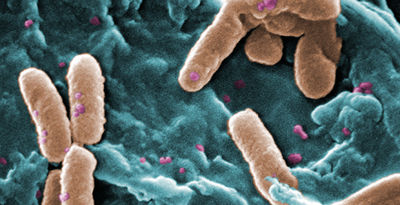Yersinia pseudotuberculosis infection: Difference between revisions
No edit summary |
|||
| Line 18: | Line 18: | ||
==Pathogenesis== | ==Pathogenesis== | ||
===Transmission=== | ===Transmission=== | ||
<i> | Although <i>Y. pseudo tuberculosis</i> is primarily a zoonotic disease, food-borne infections have been reported. Infection in humans occurs after the introduction of contaminated food products into the gastrointestinal tract. Water-borne infection has also been reported in Czechoslovakia, as well as, Okayama, Japan. (MEDSCAPE). <i>Y. pseudo tuberculosis</i> can be hosted in a number of different animal reservoirs such as: dogs, cats, cattle, horses, rabbits, deer, turkey, ducks and many others. | ||
<br> | <br> | ||
Revision as of 21:05, 16 July 2014


Etiology/Bacteriology
Taxonomy
| Domain = Bacteria
| Phylum = Proteobacteria
| Class = Gamma Proteobacteria
| Order = Enterobacteriales
| Family = Enterobacteriaceae
| Genus = Yersinia
| species = Pseudotuberculosis
Description
Pathogenesis
Transmission
Although Y. pseudo tuberculosis is primarily a zoonotic disease, food-borne infections have been reported. Infection in humans occurs after the introduction of contaminated food products into the gastrointestinal tract. Water-borne infection has also been reported in Czechoslovakia, as well as, Okayama, Japan. (MEDSCAPE). Y. pseudo tuberculosis can be hosted in a number of different animal reservoirs such as: dogs, cats, cattle, horses, rabbits, deer, turkey, ducks and many others.
Infectious Dose and Incubation Period
Characteristic of other Yersinia infections, Yersinia pseudotuberculosis requires a dose of 109 organisms to cause disease. The incubation period of Y. pseudotuberculosis is 5-10 days, however durations of 2-20 days have been reported in occasional outbreaks with the average time being 4 days after exposure to the bacterium.
Epidemiology
Virulence Factors
Yersinia pseudotuberculosis has a number of virulence factors that contribute to the pathogenicity of the organism.
Yops
Y. pseudotuberculosis contains a 70-kd plasmid that encodes for a type III secretion system that delivers the Yersinia outer proteins (Yops). There are four major Yops proteins which are essential to the pathogenicity of Y. pseudotuberculosis: YopE, YopJ, YopT, and YopH. YopE activates the RhoGTPase of the GTP-binding protein, which plays a role in the actin filament arrangement, promotion of cell rounding, prevention of host cell membrane pores, and inhibition of phagocytosis (MEDSCAPE). YopE also plays a role in decreasing the host cells proinflammatory signals by decreasing the production of interleukin-8. YopJ binds to the protein kinases which blocks phosphorylation in the cell. This will eventually lead to a decrease in the production of interleukin-8, affecting the host cells proinflammatory response. YopT disrupts the actin filament arrangement and prevents phacytosis by the host cell. YopT is not present in the pathogenic strains of Y. pseudotuberculosis. YopH contributes to the disruption of phagocytosis and actin filament arrangement. It also has a role in decreasing the secretion of interleukin-8. The four main Yersinia outer proteins work together to disrupt the host immune response.
Exotoxin-YPM
Some strains of Y. Pseudotuberculosis secrete the super antigenic exotoxin YPM, or Y. pseudotuberculosis-derived mitogen. YPM preferably stimulates the proliferation of CD4 T cells but some expression of CD8 does occur. Along with proliferation, YPM stimulates the overproduction of interleukin-8 increasing the inflammatory response in the host.
Adhesion Molecules
The adhesion molecules of Y. pseudotuberculosis bind to the host cell and facilitate its colonization in the host organism. The two major proteins of this group include: invasin and yadA. The invasin binds to the integrins of the M cells of Peyer’s patch in the small intestine. It also plays a role in internalization of bacteria across the M cells. YadA binds to laminin, collage, and fibronectin, which are bound to their receptors on the cell surface.
High Pathogenicity Island (HPI)
High Pathogenicity Island contains the gene that encodes yersiniabactin, which is used for iron uptake.
Twin Arginine Translocation (tat) pathway
The twin arginine translocation pathway is important for the secretion of proteins that function in motility and acid resistance.
Clinical Features
Diagnosis
Yersinia pseudotuberculosis has the potential to be difficult to culture because of the vast presence of healthy microbiota. A fecal sample is needed from the patient and then the microorganism can be isolated. Research has shown that cold-temperature enrichment has been effectively used to culture and isolate the microorganism. (1) Polymerase Chain Reaction assay can then be used to identify the bacteria and then can further serotype the organism. (2) The culture can also be isolated and grown on MacConkey agar due to its ability to ferment sorbitol and its ability to produce ornithine decarboxylase. (3) Y. pseudotuberculosis has been serotyped using Enzyme-linked immunosorbent assay along with agglutination tests but the results prove inconclusive due to the possibility of cross-reactions of other pathogenic antibodies. (3) Blood samples can be taken and tested to confirm the presence of the microorganism but a fecal sample is the preferred method of diagnostic testing. (2)
Treatment
Prevention
Host Immune Response
